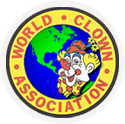When a few people get a taste of training in the art of clowning, they often band together into a clown alley for increased education and performance opportunities. These new clown alleys have enthusiasm and motivation and want to learn everything they can to improve their skills. They begin to show up in community activities such as parades and craft fairs. They attend workshops and seminars on clown education. They support each other in growing in their clown skills.
As the alley becomes more established and time goes on, some of the members will begin to clown part-time or full-time for their personal income. The clowns working for income in this art will be doing parties, picnics, schools, malls, and whatever other shows they can for income. At this point, the alley begins to experience some changes. Alleys begin to see a decrease in their participation level even though they may have an increase in membership. The alley leadership begins to wonder how to motivate the members to do alley clowning instead of individual clowning. The community impact from the clowns begins to happen in a different way, with more personal clown appearances and less group involvement in large community parades and projects.
As far as community impact is concerned, remember that your alley is comprised of the members and their individual visibility as a clown reflects on the entire clown alley. They may put a line on their business card saying they are a member of the alley. Their impact on the community represents “clowns in general” as well as their alley affiliation and their individual business.
At this point, in order to motivate the most members, the alley may begin to specialize in performance opportunities for larger groups of clowns. Perhaps the alley will set up an organized schedule of nursing home visits or a program of “clowns on call” with a local hospital. The alley may begin to focus on parades and develop themes and props for the group to use in local parades or group functions. The alley may want to set up fund-raising activities for local charities such as a basketball game between the clown alley and the local police or firefighters with the proceeds to go to a related charity. One alley I belong to scheduled a community open house for their 15th anniversary and got a donation of the civic center to use for a whole day of clown shows, games, face painting, and balloons free of charge to the community. This alley also did a week of activities this past summer for the community with a “bowl with a clown day”, a “miniature golf with a clown day”, a community car wash done by the clowns in makeup and clown swimsuits. Serving as helpers for a charity walkathon or collecting money for Red Nose Day also keeps the alley visible and impacts the community for good.
New alleys have a camaraderie because of similar desires for education, support, and fellowship related to the clown art. New clowns are motivated by workshops and seminars that help to make them better, more professional clowns. Established alleys may be better served, however, to specialize in group clown activities to motivate their members rather than increased individual training or show opportunities. Some clown groups help their members develop their competition skills for clown conventions. Some gather together just for fellowship and group fellowship events might include field trips to see a circus or comedy show or perhaps a potluck dinner just for fun rather than another workshop on basic balloons.
The important thing to recognize is that clown alleys are not all alike. Depending on the makeup of their membership, the individual skills of their members, and the length of time the alley has been in existence, there will be different needs and priorities. Look closely at your clown alley and see if you have changed in the last few years. Do you have less participation than before? Are the leaders constantly struggling to get the alley motivated? Do you have a lot more professional working clowns than you used to? Do members come out more for educational events or social events? Has there been a change in the number of people who can do day shows during the week versus evening or weekend shows? Clown alleys are formed to bring happiness and entertainment to their local communities. Are you accomplishing this more as a group alley or as a group of individual entertainers?
Remember that no matter what the answers above were for your clown alley, it’s OK because each group is different. It just might mean that you have to rethink your alley goals and motivations and work around the individual members. The good news is that changes like those listed above occur as your alley grows and increases in skills. With the growing pains of increased skills and experience levels for the individual clowns comes a broader perspective that might mean your alley is ready to run a weekend educational seminar or host a regional or national convention. Clown alleys that have been in existence for a long time have lived through changes in membership, attitude, skill levels, and priorities and have continued to exist because they were flexible enough to make the changes required by the growing pains.
